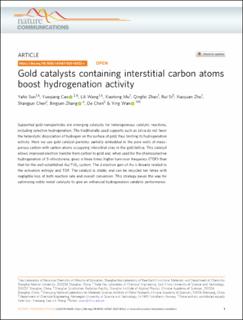| dc.contributor.author | Sun, Y. | |
| dc.contributor.author | Cao, Y. | |
| dc.contributor.author | Wang, , L. | |
| dc.contributor.author | Mu, , X. | |
| dc.contributor.author | Zhao, Q. | |
| dc.contributor.author | Si, , R. | |
| dc.contributor.author | Zhu, , X. | |
| dc.contributor.author | Chen, , S. | |
| dc.contributor.author | Zhang, , B. | |
| dc.contributor.author | Chen, De | |
| dc.contributor.author | Wan, Ying | |
| dc.date.accessioned | 2022-09-01T09:05:44Z | |
| dc.date.available | 2022-09-01T09:05:44Z | |
| dc.date.created | 2021-01-28T20:43:45Z | |
| dc.date.issued | 2020 | |
| dc.identifier.citation | Nature Communications. 2020, 11 1-9. | en_US |
| dc.identifier.issn | 2041-1723 | |
| dc.identifier.uri | https://hdl.handle.net/11250/3015052 | |
| dc.description.abstract | Supported gold nanoparticles are emerging catalysts for heterogeneous catalytic reactions, including selective hydrogenation. The traditionally used supports such as silica do not favor the heterolytic dissociation of hydrogen on the surface of gold, thus limiting its hydrogenation activity. Here we use gold catalyst particles partially embedded in the pore walls of mesoporous carbon with carbon atoms occupying interstitial sites in the gold lattice. This catalyst allows improved electron transfer from carbon to gold and, when used for the chemoselective hydrogenation of 3-nitrostyrene, gives a three times higher turn-over frequency (TOF) than that for the well-established Au/TiO2 system. The d electron gain of Au is linearly related to the activation entropy and TOF. The catalyst is stable, and can be recycled ten times with negligible loss of both reaction rate and overall conversion. This strategy paves the way for optimizing noble metal catalysts to give an enhanced hydrogenation catalytic performance. | en_US |
| dc.language.iso | eng | en_US |
| dc.publisher | Nature Research | en_US |
| dc.rights | Navngivelse 4.0 Internasjonal | * |
| dc.rights.uri | http://creativecommons.org/licenses/by/4.0/deed.no | * |
| dc.title | Gold Catalysts Containing Interstitial Carbon Atoms Boost Hydrogenation Activity | en_US |
| dc.title.alternative | Gold Catalysts Containing Interstitial Carbon Atoms Boost Hydrogenation Activity | en_US |
| dc.type | Peer reviewed | en_US |
| dc.type | Journal article | en_US |
| dc.description.version | publishedVersion | en_US |
| dc.source.pagenumber | 1-9 | en_US |
| dc.source.volume | 11 | en_US |
| dc.source.journal | Nature Communications | en_US |
| dc.identifier.doi | 10.1038/s41467-020-18322-x | |
| dc.identifier.cristin | 1881708 | |
| cristin.ispublished | true | |
| cristin.fulltext | original | |
| cristin.qualitycode | 2 | |

